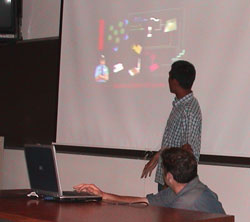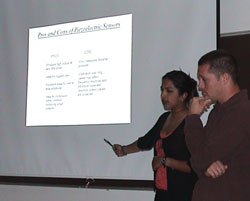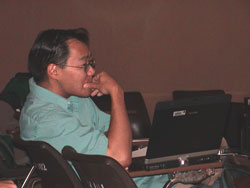UCSD Division Spearheads First Sensornets Course
 Andy Aoe, presenting his team's "Multi-modal Mobile Security System" |
"This was an exciting opportunity for students to learn about some of the fundamental concepts in sensor networks as well as a wide variety of recent research such as the High Performance Wireless Research and Educational Network, the Virtual Seismic Network, battery management techniques, and even using bees as biosensors," says Okino.
A key part of the course involved teams of students proposing sensor network applications, developing high-level system architectures, and identifying tradeoffs or analyzing performance for a particular part of their networks.
|
"Each team was led, by design, by a student outside of the Electrical and Computer Engineering Department to force the issue of interdisciplinarity," says Okino. "We spent the first two weeks proposing and 'bartering' to shape the projects, so the students had less than three weeks left to figure out how to work together and who would take responsibility for which aspects of the projects."
Robert Stacey, Bala Ramasay, and Joey Ho presented "A Portable Air Vent Calibration System," applying wireless temperature, noise, and ultrasound sensors to enable a more efficient installation technique for an air conditioning system in a multi-room environment. Their conclusions characterized some of the cost/benefits of using a collection of sensors in an automated calibration system for a large number of rooms
Steve Rodriguez, Andy Aoe, and Aaron Bell presented a "Multi-modal Mobile Security System," consisting of FM acoustic sensor nodes, ultrasound motion detectors, and surveillance cameras. Their system uses a combination of staged event-driven processing, data fusion, and selective transmission schemes to increase the life expectancy of the security system as wells as improve detection capabilities and reduce false alarm scenarios. Potential applications include construction sites (including house additions) and special events.
Matthew Lafiandra, William Mulyadi, and Kent Ragay presented "FireNet," a sensornet to battle wildfires. It was designed to monitor the speed and direction of approaching and shifting wind fronts, sending the data to a computer deployed on an emergency response vehicle, which in turn would relay the data to fire fighters in the field. The team used simulations to evaluate the effects of changes in wind speed and topographic slope on the rate of spread of a wildfire. They suggested that the design could be enhanced with humidity and temperature sensors and sensors integrated into the fire fighters' equipment and clothing. Advances in electronics would enable smaller, lighter (i.e., more portable) equipment; advances in communications would increase the range over which the sensors could be deployed. The team also identified the potential market for this system, noting that last year $1.6B was spent battling wildfires in the U.S.; even so, 7M acres still burned.
Cynthia Ratnakumar, Steve Walsh, Jalloh Mohamed, and Robb Raffaelli presented a "Downhole Noise Sensor Network," a pressure-sensing system designed for use inside oil wells to enable a technician in a central location to easily monitor the status of multiple wells. This team addressed the issue of data fusion showing that for specific sensor types, combining lower-cost sensors produced a more accurate and less expensive composite system.
Tim Hwang, Payton Chu, and Samuel Chieh presented "Distributed Seismic and Radionuclide Sensors," a sensornet to increase the effectiveness of monitoring for compliance with the Comprehensive Test Ban Treaty. It was designed to use seismic sensors to detect waveform signals, then compare their characteristics with those of nuclear explosions. Given a "match," the seismic sensors would be turned off and radionuclide sensors would be turned on to conduct intermittent sampling of continuing signals. This team addressed the issue of device life by proposing a software protocol to time when power would be applied to the system, the use of a pulsing battery technique, and a two-layer system of insulation material to reduce heat and moisture entering the system.
The last team to present, Chengyu Sung, Chris Hiestand, and Shadi Ghandchi, proposed "Battlefield Sensors" to track the paths of tanks through a battlefield. This team, after running a series of simulations studying various tradeoffs between the size of the field and the density of sensors, parametrically identified the capability of detecting and tracking per the number of sensors in a sensor field capturing the sparseness of nodes required for a given performance metric.
"Sensor networks are rapidly becoming a ubiquitous aspect of our daily lives," says organizer Hodgkiss, a professor of Electrical and Computer Engineering and at the Scripps Institution of Oceanography. "As demonstrated by the student projects, the application areas are quite broad, and each required a team with multiple talents. Our hope is that this course has exposed students to a new perspective on sensing and sensor networks and that it will encourage them to contribute to advances in these areas."



